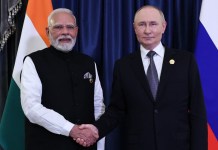Is the Kashmir Valley more culturally similar to the Central Asian countries like Tajikistan and Uzbekistan instead of the rest of South Asia? Despite being the hub for Kashmir Shaivism and spirituality, Islam entered into Kashmir via Tajikistan through Iran. This is not the only linkage between Kashmir and Central Asia and influences can be seen in cuisines, clothing, designs and most notably the physical features of the people symbolized by a long nose and light skin colour. Should the lost connectivity between Kashmir and Central Asia be reviewed?
Uzbekistan a Key Cog in the Wheel for India’s Central Asia Policy
Narendra Modi Connecting India with Central Asia
The Act East Policy initiated by Prime Minister Narendra Modi has yielded multiple alternatives and a much-needed reach to the Central Asian nations. The revival of Central Asian roots through the involvement of Kashmir would do good to the heavy pitfalls faced by militarisation in the region.
The revival of historical and civilisational links between Kashmir and Central Asia could help the state recover from its chaotic reality. A situation that is similar to those of Odisha, Gujarat and the seven sister states which were culturally mobilised in Modi’s first tenure. His initiatives help garner greater connectivity and interpersonal interactions.
The initiatives in states like Odisha where building linkages with Indonesia through the Kalinga revival has cemented favours with the Chief Minister Naveen Patnaik. The same mentality was inculcated by Modi during his tenure in Gujarat reviving the connections with the African continent.

His sincere attempts to initiate projects like the India-Myanmar-Thailand trilateral highway could well be seen as a step in this direction. The Kaladan multi-modal transport project to connect the Rohingya dominated Rakhine states can be seen as attempts to revive inter-connectedness.
Similar cases in South India where efforts are being made to revive the maritime and trade links similar to those of the Chola Empire in the 9th to the 13th-century. These instances are being sought as reason enough to be used as an alternative in dealing with the crisis in Kashmir, pursuing the link between Kashmir and Central Asia independent of the Indo-Pak dispute.
Blood Will Continue To Flow in Kashmir Until Genuine Demands Not Met: Unpatronized Analysis
The historical facet of Kashmir has been that of an economic hub up until the early 20th century. It was Islamic scholar Mir Syed Ali Hamadani who brought the Sufi version of Islam into Kashmir from Tajikistan through Iran.
The Soviet Union blocking of Tajikistan and the Chinese conquest of Kashgar and Tibet brought turmoil and a sense of loss in the Valley. This was further accentuated by the formation fo the Line of Control thereby completely locking up the Valley from its cultural and historical relevance.
“The abrupt disruption of linkages has created a siege mentality in Kashmir which when mixed with the political issues has become a lethal cocktail”, writes Gilani. The mind of Kashmir has become that of a prison completely locked out of relevance. The last time such an attempt to set Kashmir free was when Atal Bihari Vajpayee decided to open up the LoC for trade and travel. Thanks to the efforts of former Prime Minister Manmohan Singh the idea was made operational and a chance for positive changes was deemed possible.
It is not unknown to the world that Kashmir is spoken of only in terms of a geopolitical pawn within diplomacy. It has been completely marred of identity without turmoil, chaos and violence. Gilani quotes former Vice Chief of Indian Air Force Kapil Kak as the latter observes Kashmir commenting, “In contemporary terms its inability to connect to the world outside, whether it is trade, people and culture has affected the psyche there.” If there is any hope of change, it can only be realised when India and Pakistan can have a semblance of friendly relations. Various factions within global diplomacy see the resolution of Kashmir as doable.
The long forgotten proposals of bringing gas from Kazakhstan to India via Jammu and Kashmir should be brought back into the conversation. This could be of legitimate value with the oil wells in Gulf drying up. Uzbekistan is another modal opportunity to exploit for the nation has the 18th largest natural gas reserve in the world. This may well be the opportunity to find Kashmir at the epicentre of a transfusion of trade and value. Gilani finds it to be true that the “negative mindset” cannot be changed only through monetary appeasements.
When the world sees Kashmir as a geopolitical vantage, what remains forgotten are the people. It would more strategic to focus on interpersonal connectedness and trade than any other abstruse strategy. If the Kashmir crisis needs a tangible solution it can be achieved through the people. By building an identity, one could help build worth among the Kashmiri populous who are now lost within the quagmire of the political circus. Maybe this could be the antidote that we were looking for all these years.
With Inputs From Iftikhar Gilani writing for the AA.




